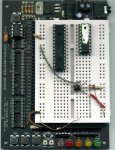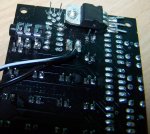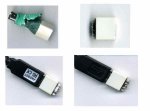Hi,
I got the AXE114S binary clock kit for Christmas and have carefully spent a month putting it all together. I've had my ups and downs as i haven't soldered anything for a long time, but i think i got it right. I've been over the board loads of times and checked the solder and it all appears fine.
It uses a PICAXE 28X, with a 9V power supply which is regulated by a device on the board. I have checked the voltage between pins 8 and 20 and between 19 and 20 and in both cases it's 4.98
I have checked the 1K and 22K resistors as well and they are all fine.
It was working OK, but when i unplugged the USB cable, it went wrong and seemed to light up LEDs at random and now i can't even download a new program to it. I get the "HArdware not found" message, or when i do a reset, i get "Memory Verification failed".
i think both these messages come from a failed Chip, so is this the most likely cause and what else can i do to rule it out?
Cheers,
Keith
I got the AXE114S binary clock kit for Christmas and have carefully spent a month putting it all together. I've had my ups and downs as i haven't soldered anything for a long time, but i think i got it right. I've been over the board loads of times and checked the solder and it all appears fine.
It uses a PICAXE 28X, with a 9V power supply which is regulated by a device on the board. I have checked the voltage between pins 8 and 20 and between 19 and 20 and in both cases it's 4.98
I have checked the 1K and 22K resistors as well and they are all fine.
It was working OK, but when i unplugged the USB cable, it went wrong and seemed to light up LEDs at random and now i can't even download a new program to it. I get the "HArdware not found" message, or when i do a reset, i get "Memory Verification failed".
i think both these messages come from a failed Chip, so is this the most likely cause and what else can i do to rule it out?
Cheers,
Keith








